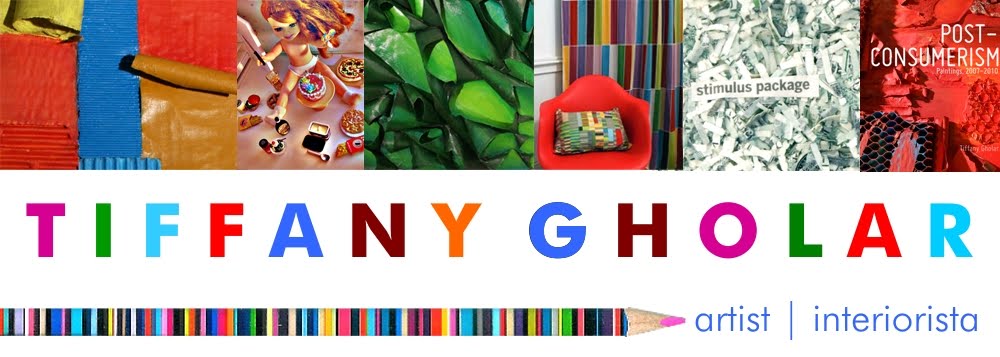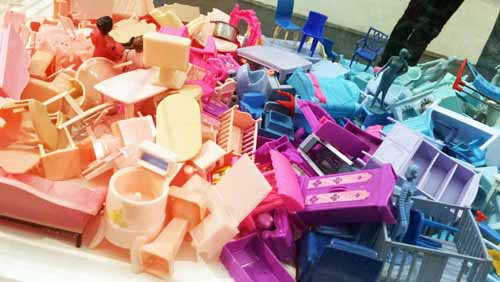If you're familiar with my blog, you probably know that Laurie Simmons is one of my favorite contemporary photographers. When I was in graduate school, I did a video presentation on her work, which you can watch in this old blog post. I've always considered her work an influence on The Doll Project. I was very excited to find out that the MCA would be featuring her work in a retrospective this year.
The show is called Big Camera, Little Camera, and shares its title with one of Laurie Simmons' first photos using miniatures. What I like about her work is that it's often whimsical, or appears so at a distance, until you take a closer look.
When I was working on my video presentation, I saw clips of her film, The Music of Regret, and she talked about the process of making it in her interviews. But as an art film, it's not readily available to view. So I was very happy that it was playing in one of the galleries in the show. It is a musical in three acts and features original music, puppetry, ventriloquist dummies, and a performance by Meryl Streep. It brings her still photographs to life.
There was a glass case with many of the miniature props she used in her photographs. Most of the dollhouse furniture is plastic, and appears to be 3/4" scale. My guess is that a lot of it was made by companies like Marx to go into the tin dollhouses they made in the 1940s through the 1960s.
Her work with miniatures led to an opportunity to create The Kaleidoscope House with architect Peter Wheelwright for Bozart toys in 2001. My Kaleidoscope House is the jewel of my dollhouse collection and I was glad to see one on view in the museum. The other people visiting the show seemed to enjoy it too. Accessories for the house were sold separately. There were sets of contemporary miniature furniture by designers including Ron Arad and Karim Rashid, as well as miniature artwork by artists including Barbara Kruger, Cindy Sherman, and Laurie Simmons. The house itself is a spiritual successor to the Imagination House made by Marx toys in 1965. Action figures based on the artist, the architect, and their children were also sold separately, and they are featured in the museum's dollhouse.
The museum itself resembled the Kaleidoscope House in some ways, thanks to the site-specific work on the windows and atrium wall by Federico Herrero and the rainbow of products from the museum store arranged on this table by hue.
I was able to attend Laurie Simmons' opening day talk in the museum's auditorium. While we sat waiting for it to begin, there was a sudden outcry from a young woman sitting a few rows behind me. She stood up and directed her anger at Lena Dunham, who was sitting in the front row. Lena Dunham is Laurie Simmons' daughter. Over the years, in addition to making a feature film and a TV series for HBO, Lena Dunham has also made a lot of truly awful public statements, particularly on Twitter. The angry young woman had come to confront her about a particularly egregious one, in which she came to the defense of a friend of hers at the expense of the actress who accused him of assault. She later apologized, after articles like the one I linked to and numerous people with Twitter accounts called her out on her egregious behavior. The young woman's solitary protest in the auditorium was a continuation of that, angrily questioning the supposed feminism of a woman who called a rape survivor a liar. Immediately afterwards, Lena Dunham stood up and yelled to the protester that she was a real person with feelings, not just someone on Twitter, and that she had apologized. The young woman stormed out before security could escort her out. A tense silence fell over the room. We had all just witnessed an all-too common occurrence from Lena Dunham's public life, only in person and not on social media: the call-out, her defense, the apology that still comes off as self-centered somehow. And yet, after hearing her voice and the pain in it, as opposed to just reading a screenshot of a tweet on a screen, I found myself feeling bad for her. But I felt worse for the young woman who had spoken up before leaving, who told Lena Dunham that she was a rape survivor herself. I had been in the middle of a tweet about the show when the commotion began. In the uneasy quiet that followed, I decided not to tweet about the incident. I decided to save that for this blog post, where I have more that 280 characters at a time to tell the story.
I'd had a bad feeling that something like this might happen from the moment I read about the public appearances that Laurie Simmons would be making. Her daughter has become a lightning rod for criticism, and for good reason. In the era of the #MeToo movement, there is a lot of discussion about separating the artist from the art, but now I was wondering if you could separate the artist from her family. Because I like a lot of Laurie Simmons' work, but Lena Dunham has been consistently problematic.
The program began as if nothing unusual had preceded it. Throughout the talk, I was worried that something else would happen, but nothing did, not even when the time came for questions from the audience. In her talk, Laurie Simmons shared clips of favorite films that she references in her new film, My Art. She talked about an interesting theme she had observed in several of them, including Bell Book and Candle, that when women fall in love, they lose their powers. She said that she feels like artists are vampires using everything around them to make their art. She likes to use dolls, mannequins, and other stand-ins for live human models in her work to find the truth in artifice and is unapologetic about her love of fashion and its relevance to her work. During the course of the show, those who have been impacted by the gender pay gap will have the opportunity to get discounted tickets to the MCA.
The show continues through May 5th and the schedule for My Art screenings is at this link.
UPDATE, 3/28:
I was so distracted by what happened at the artist talk that I neglected to mention something else that's problematic about this show. I don't spend much time looking at art that I don't like or blogging about it because I think life's too short for that and I'm not interested in being an art critic, but fellow Chicago artist Jenny Lam wrote about it on her blog. I was remiss not to mention it. I didn't spend much time looking at The Love Doll series because, like the How We See series, I found it creepy and weird. If I had taken the time to pay attention to it instead of walking past it quickly, I think I would have come to the same conclusions that Jenny Lam and her friend Trilbe Wynne did, which is that it's very stereotypical. For an artist so interested in how women are stereotyped in media, her treatment of Asian women in her work is a prime example of what feminists of color mean when they talk about "white feminism." Like mother, like daughter, tiny furniture is what Laurie Simmons does best.


















No comments:
Post a Comment